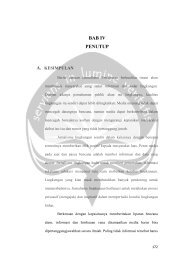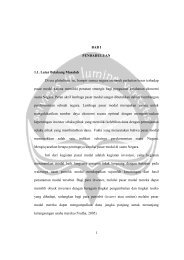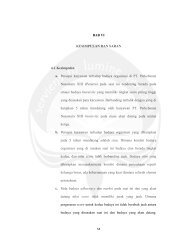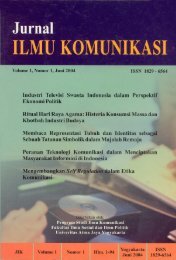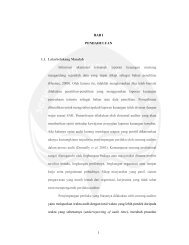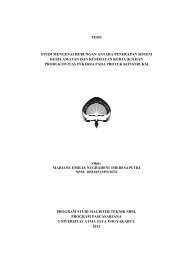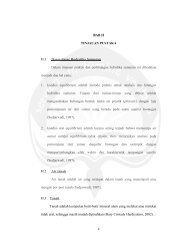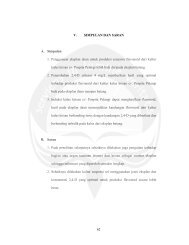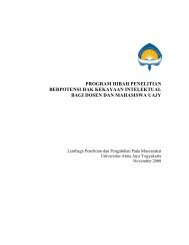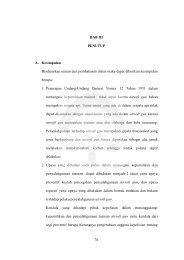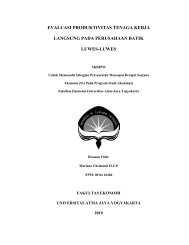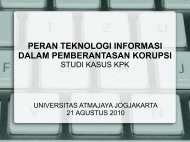1 CHAPTER I INTRODUCTION 1.1. Background The development ...
1 CHAPTER I INTRODUCTION 1.1. Background The development ...
1 CHAPTER I INTRODUCTION 1.1. Background The development ...
Create successful ePaper yourself
Turn your PDF publications into a flip-book with our unique Google optimized e-Paper software.
<strong>CHAPTER</strong> I<strong>INTRODUCTION</strong><strong>1.1.</strong> <strong>Background</strong><strong>The</strong> <strong>development</strong> of construction industry in Indonesia is more complexrelated to the regulation of new standards, new technologies, and ownerdesirability that always want to make construction effectively and efficientlyfollowed with satisfying result. <strong>The</strong>se cause ready mix concrete companies toemerge later, especially to support a concrete construction. However, economiccrisis that attacked Indonesia in the late 1997 had made condition whereconstruction industry market become decreased more and more competitive aswell with the ready mix concrete companies.For ready mix concrete company, efforts searching to reduce risks factorthat occur because of that condition is one way to survive in regional market. Infact, ready mix concrete in construction project can be one of most effective wayas it accelerates concrete pouring, it doesn’t need certain place to stock materialon project site, etc.Nevertheless, in order to do this effort, also found risks factor that canaffect success level from a ready mix concrete company. Between all risk factors,some of them are related with production, logistic, finances, and marketing. Thoserisks that are dealt with may disturb ready mix concrete company businessfluency; even it may bring the company to a loss. <strong>The</strong> size of loss depends on thesize of risks that are dealt with. If the risk is big then the company is threatened by1
2a big loss too. So does the opposite, if the risk is small then the company isthreatened by a small loss. Risk in a company basically cannot be removed and itcan influence productivity, shape, quality, and cost of a company (Kangari, 1995).To manage and reduce effects from those risks, a strategy is developed,called risk management. Considering nowadays condition in Indonesia, riskmanagement could be one of most important strategy that can manage risks factorexist.1.2. Problem StatementThis research will cover the problems of:What is the best way to manage risk management in a ready mix concretecompany, especially at operational sector?1.3. Problem LimitationIn order to limit the problems, limitation is needed for this topic. This topicconcerns about to find risks, to analyze them and to found methods facing risks atoperational sector, at three ready mix concrete companies in Yogyakarta andsurroundings. Companies that are being observed are PT. Jaya Alam SaranaBeton, PT Karya Beton, and PT Jaya Ready Mix. While operational sectors thatare being researched is following:1) Production sector2) Logistic sector3) Finance sector4) Marketing sector
31.4. Expected Benefit of the Study1) For ready mix concrete company:<strong>The</strong> benefit of this study is to assist the company to realize risks that mayoccur, to know how to avoid and to find solutions for those risks.2) For observer:This research end result could be reference for next research about riskmanagement at operational sector of ready mix concrete company,therefore far-ranging knowledge could be obtained.1.5. Objective of the <strong>The</strong>sis<strong>The</strong> objective of this thesis is to identify how to manage risk managementat three ready mix concrete companies, as following:1) To identify and to evaluate (to measure its frequency and effect) from eachrisk that occurs at a ready mix concrete company.2) To select a method and to implement the method chosen.3) To control risk management with comparison between planning andactual.1.6. Outline of the <strong>The</strong>sisThis thesis is divided into five chapters. It consists of introduction,literature review, research methodology, data analysis and discussion and the lastone is conclusion and recommendation.
4<strong>The</strong> first chapter of this thesis is introduction. It is divided into sixsubchapters which are background of the study, problem statement, problemlimitation, expected benefit of the study, objective of the study, and the last one isoutline of the thesis.<strong>The</strong> second chapter is literature review that contains literature study whichsupports the thesis.<strong>The</strong> third chapter is research methodology. It talks about how to collectand analyze the data for this thesis.<strong>The</strong> fourth chapter is data analysis and discussion. It talks about the dataanalysis from the data that have been obtained before and discuss.<strong>The</strong> fifth chapter is conclusion and recommendation. It contains theconclusion of the thesis and the recommendation to encourage this thesis.



